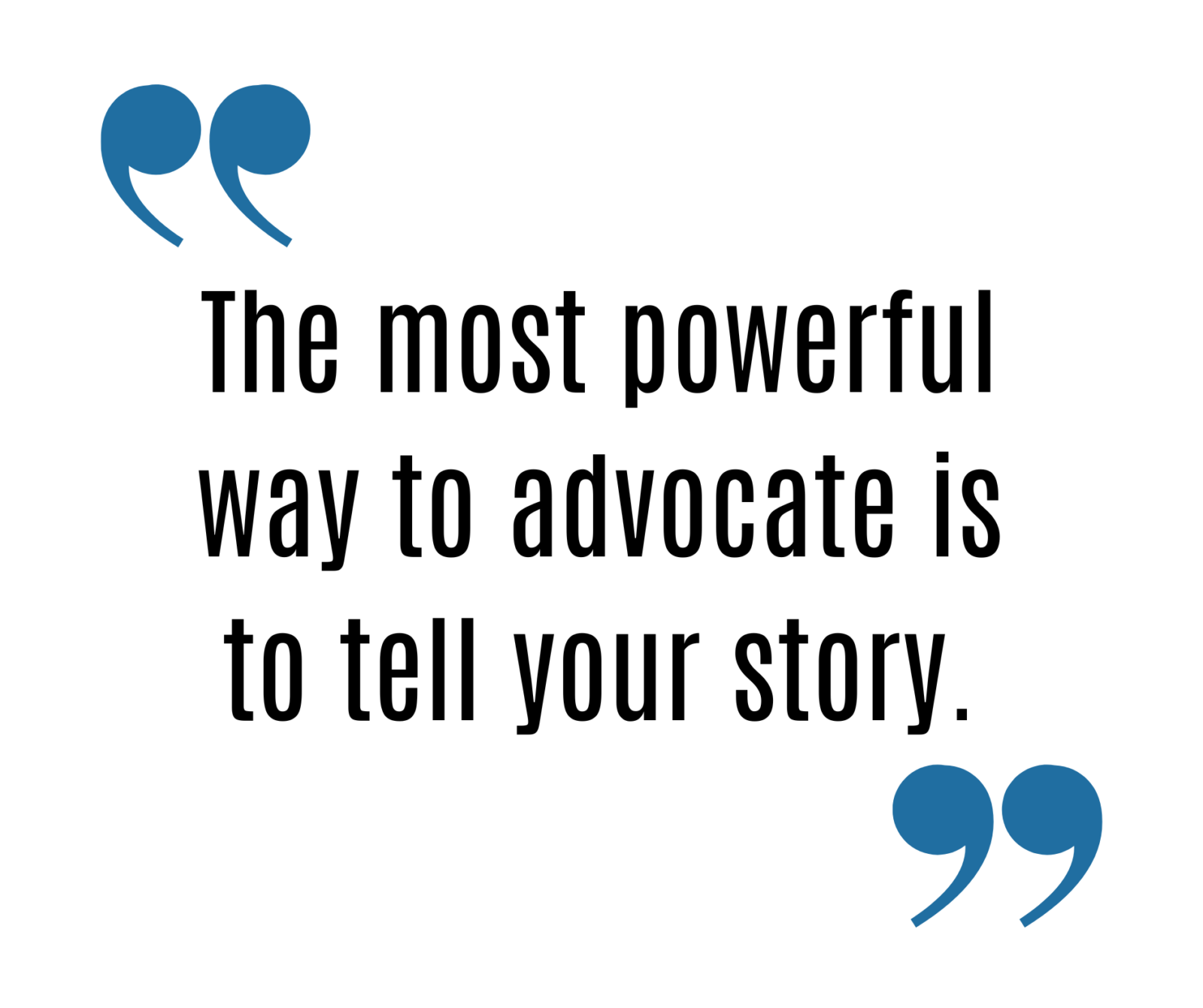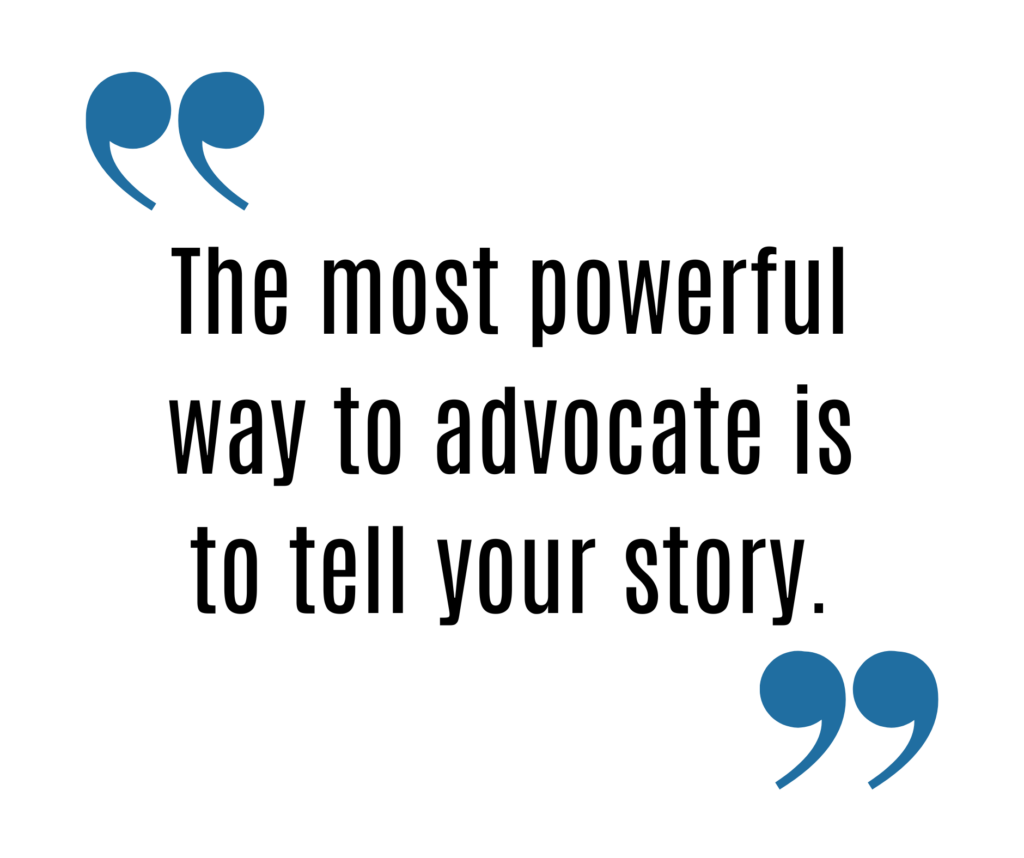
If you have thoughts about changes that are being made to government, policies, and programs, and you want to know how to take action, please read on.
A PDF version of this toolkit can be accessed here.
Everyone in the United States has certain rights and responsibilities. This includes people who are not citizens and people who are under guardianships or conservatorships. This toolkit explains the rights and responsibilities you have in advocating for policy change. It describes ways to tell the government what we want and what we do not want. The toolkit also provides links to more information.
Right now, people with disabilities and our allies are working on an important issue: proposed changes to Medicaid. This toolkit focuses on Medicaid, although you can use these ideas to advocate for any kind of policy changes that are important to you. The most powerful way to advocate is telling your story. How does Medicaid help you live where and how you want? What would happen if you didn’t have Medicaid?
Medicaid can have different names in different states. Medicaid helps make sure people who need nursing home care and personal care services can get those services. Nursing home care and personal care services are usually not covered by other insurance. Many people with disabilities, including many people who need and use augmentative and alternative communication (AAC), need personal care services to live in their community. This is why Medicaid is so important to us.
The word Medicaid is not always in the name of a state’s Medicaid program. You can search for your state’s Medicaid name in a database. States whose Medicaid programs do not contain the word Medicaid (and what they call it instead) are also listed here.
Rights and Responsibilities
In a democracy, all citizens have the right to tell the government what policies we want and do not want. There are many ways we can tell the government what we want.
People who cannot rely on speech alone to be heard and understood have other rights, too. The Americans with Disabilities Act (ADA) protects people with disabilities. Section 504 of the Rehabilitation Act also protects people with disabilities. Students with speech-related disabilities are protected at school by the Individuals with Disabilities Education Act (IDEA). The Civil Rights Act of 1964 protects people from other kinds of discrimination, including discrimination based on race, religion, sex, and national origin. Medicaid ensures that we get the medical care and personal care attendants we need to live in the community.
 In a democracy, the government is put in place to work for the public’s interest. It is important for the government to know what is in the public’s interest and what is not in the public’s interest. The best way for them to learn about that is by hearing from the public! You can tell the government what policies and programs you need and want to see. If enough people work together to ask for the same policies, the government will act.
In a democracy, the government is put in place to work for the public’s interest. It is important for the government to know what is in the public’s interest and what is not in the public’s interest. The best way for them to learn about that is by hearing from the public! You can tell the government what policies and programs you need and want to see. If enough people work together to ask for the same policies, the government will act.
It does not matter who you voted for. It does not matter which party you prefer. It is important to think about policies. Policies are rules, guidelines, and ideas that affect things like programs and laws. Policies might decide how much funding a program receives, or who is eligible for a program. Medicaid is a program affected by lots of policies.
When you understand how policies impact you, you can advocate for policy changes that would make your life better. It is your responsibility to tell the government which policies you support. It is your responsibility to tell the government which policies you do not support. That’s how elected officials know what to do.
Advocating
There are many ways to advocate and to let the government know what you need, want, and think. Right now, it is very important to advocate for Medicaid.
Contact Your Elected Representatives
You can tell your elected representatives what you want the government to do and not to do. The best way to do this is to tell them a story. Then, tell them what you want them to do.
Right now, we are suggesting that you contact your members of the United States Congress, including your Representative and Senators.
To tell your elected representatives what you want the government to do and not to do, you can:
- Send them an email
- Fill out a form on their website
- Call them on the phone or use a relay service
- Mail them a letter
- Meet them in person
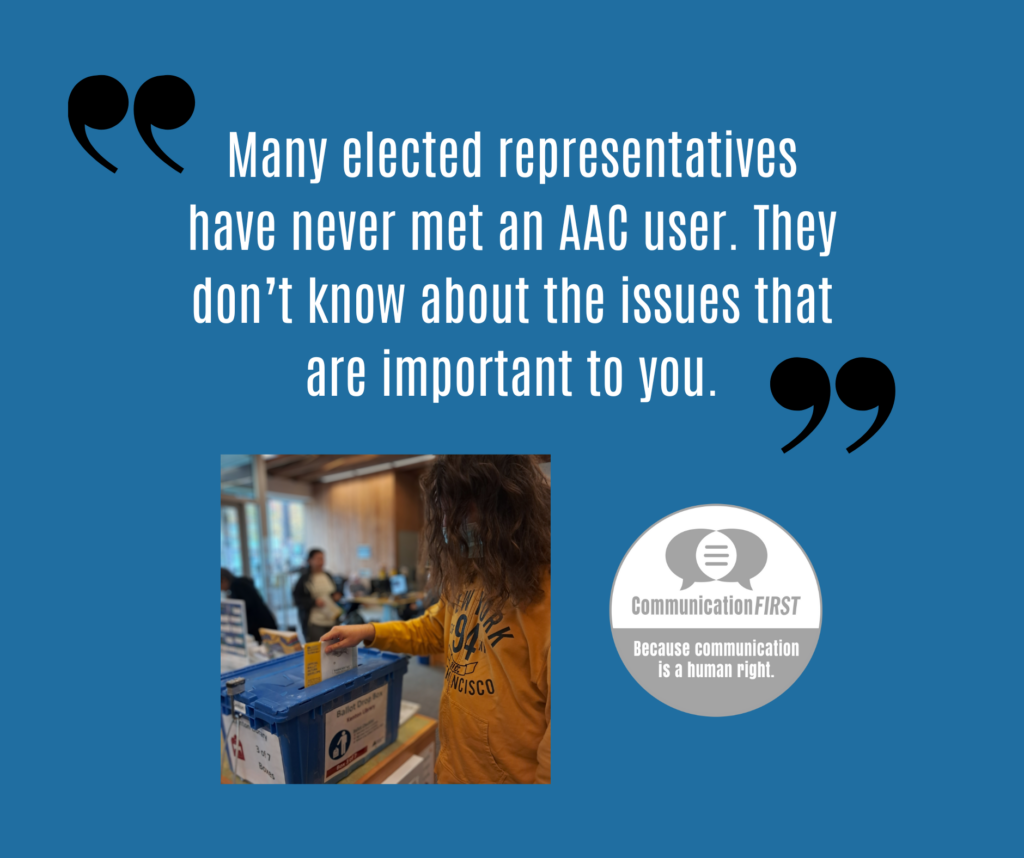 Many elected representatives have never met an AAC user in person before. They may not know about a lot of the issues facing people with speech-related disabilities. They may have never heard of AAC before. They may wrongly believe that people with speech-related disabilities cannot communicate. Because of this, meeting your elected representative in person as an AAC user can be very powerful. It can change the way that they think about speech-related disabilities and the disabled people that they represent.
Many elected representatives have never met an AAC user in person before. They may not know about a lot of the issues facing people with speech-related disabilities. They may have never heard of AAC before. They may wrongly believe that people with speech-related disabilities cannot communicate. Because of this, meeting your elected representative in person as an AAC user can be very powerful. It can change the way that they think about speech-related disabilities and the disabled people that they represent.
How to set up meetings with your federal representatives:
Each state has two Senators. States have different numbers of House representatives based on how many people live in your state, but you have only one U.S. Representative.
- Who? You can use this tool to find out who represents you in the Senate and House.
- When? Congress is in recess from March 15 to 23 and April 12 to 27. During this time they are in their home districts (near you).
- Where? You can set up meetings in Washington, D.C., or in your own state. Senators may have multiple offices around your state. House Representatives may have only one office for your district. It depends how large your district is.
- What? You can request meetings with your representatives. Sometimes they will meet with you personally. If they are not available, they will assign a staff member to meet with you and report back to them. Whether you meet with your representative or their staff members, they will pay attention to what you say.
- How? In order to set up these meetings, visit your representative’s website. There will be a page dedicated to setting up meetings, often found under “Contact.” Find that page, and follow the instructions. You can request disability accommodations for the meeting. Your representative might have specific instructions about how to request accommodations. Even if there are no specific instructions, you can still request accommodations. You may want to write the accommodations you will need at the end of your request to schedule a meeting.
- Sometimes your representatives will set up local meetings or “town halls” to hear from the people who elected them. You can find out about this on their website, or sometimes through social media or their mailing list.
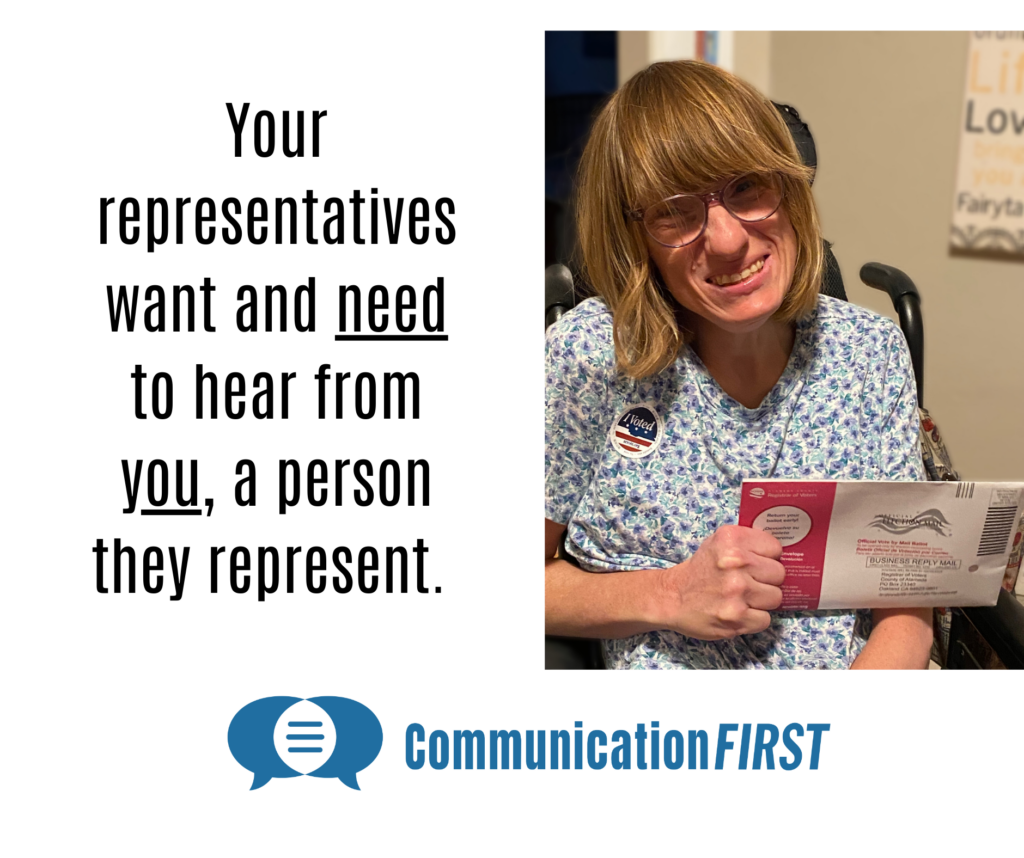 How to set up meetings with your state representatives:
How to set up meetings with your state representatives:
Each state in the United States has multiple elected representatives, such as a governor, attorney general, and State Senators. State Senators are different from the federal representatives in the US Senate. They work on policy at the state level instead of traveling to Washington, D.C. to work on policy for the whole country. States have freedom about how to organize themselves, and each state may have different names for some of the elected officials.
State representatives cannot affect the federal budget. However, they may have an impact on how it is spent within your state. State representatives also cannot make federal (national) laws. However, they can help to make laws and policies in your own state.
- You can use this tool to find your state representatives. After putting your address in the form, drop-down menus will appear that name your federal, state, and local officials.
- Choose the state officials menu to find the names of your representatives. There will be a link to their website that you may use to find out how to set up a meeting with them. Some elected representatives, such as governors, may only schedule meetings with groups or to attend events. Others may meet with you one on one, similar to your federal representatives.
- You can request disability accommodations if you need them. If the instructions do not tell you how to request accommodations, include the accommodations you need in your meeting request.
- Sometimes your representatives will set up local meetings or “town halls” to hear from the people who elected them. You can find out about this on their website, or sometimes through social media or their mailing list.
What should you say to your elected representatives?
Once you have set up a meeting with your representative, you may not know what to say. There are two guiding principles we suggest:
- Do your research on what your representative has the power to do. If you want to advocate for a policy change at the national level, make sure you are meeting with a representative who works at the federal level: a Senator or a member of the House of Representatives (your U.S. Representative). If you want to advocate for a policy change at the state level, make sure you are meeting with a representative who works at the state level. A State Senator will not be able to change national policy, and a member of the House of Representatives will not be able to change state policy. Look for policies that match the duties of the person you are meeting with.
- Once you choose which policies you want to advocate for, make sure you do some research on those policies. Know what you want to change or what you don’t want to change. Be clear about why.
Use these two guiding principles to plan a small number of “talking points.” Talking points are short statements that make your position clear to the person you are meeting with. You might find suggested talking points from advocacy organizations such as the Arc of the United States, the Autistic Self Advocacy Network, and Justice in Aging. You might also create your own based on your own research. It can help to plan your talking points ahead and practice discussing them, such as with a friend or relative who will act out the conversation with you. You may want to save your talking points into your AAC device if you have one that stores phrases, or write them out in advance.
Telling personal stories is really powerful. One way to explain your position is to tell a short story about how a policy impacted you, or how you were impacted because a policy doesn’t yet exist. After telling your story, tell your representative what you would like them to do.
You won’t have a lot of time with your representative, so don’t try to fit too many things in all at once. If you want to comment on multiple issues, you can try to schedule multiple meetings.
It can help to bring a one-page, printed document that summarizes each of your points and why it is important. You can leave that with your representative or their staff member to help them remember exactly what you said.
What if you don’t want to meet your elected representatives in person, or can’t set up a meeting?
Many elected representatives have multiple ways to contact them. These may include email, filling out a comment form on their website, calling them on the phone or using TTY/TTD, or mailing them a letter. Your representatives will tell you which methods you can use to contact them on their website.
Our colleagues at Autistic Self Advocacy Network created this fact sheet that explains how you can call your representatives. It includes several helpful scripts that you can use to prepare your statements when you call, including a script for AAC users. They have a proxy caller service. You can write or adapt a script for what you want to tell your Representative. A volunteer will call your Representative and tell them what you said.
What are some other ways to advocate for or against policy changes?
Contacting your elected representatives is not the only thing you can do.
Share your views and experiences:
Share your views and experiences with people you know. You can also share your views and experiences with other people, such as at Town Hall meetings or other events. You may want to build coalitions. Coalitions are when a group of people who may have different experiences and needs work together on an issue. Some people share their views and experiences by writing blogs, making art, or public presentations.
If you meet with your representative, either one on one or at events like Town Halls, ask for a photo with them. You can then share that photo on social media with a statement repeating your views and what you asked your representative to do.
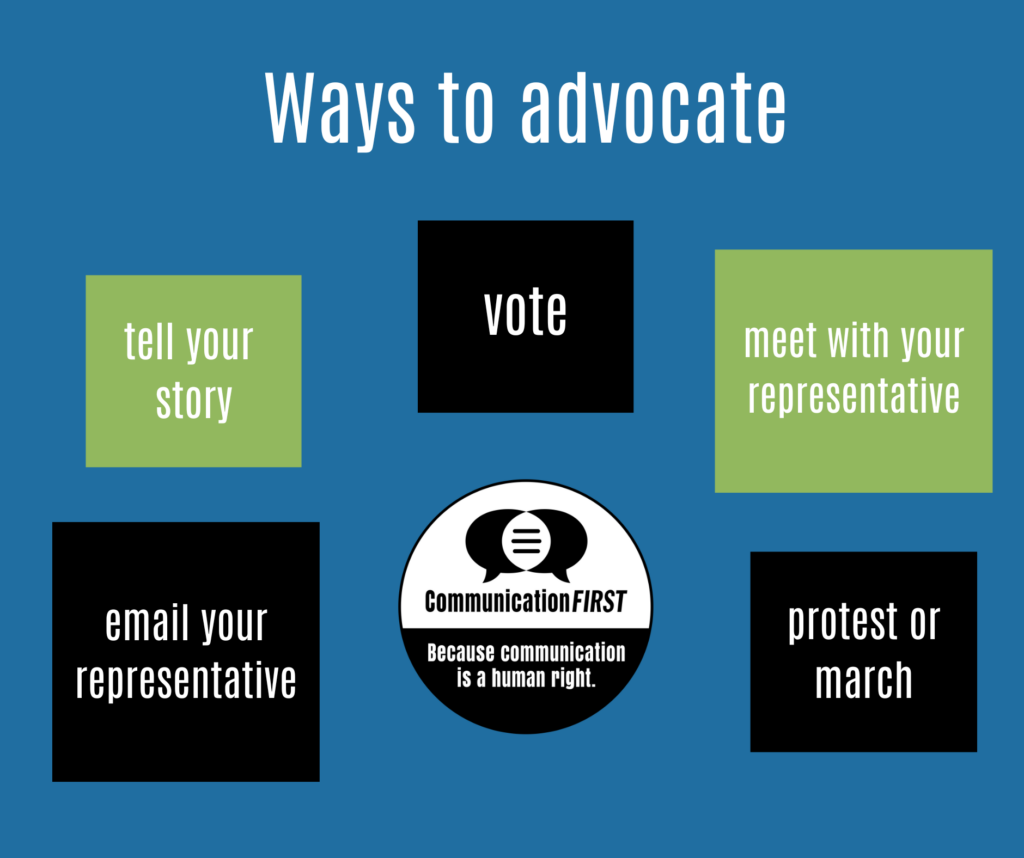
Vote:
If you are able to vote, we encourage you to do so. Find out how your how elected officials have voted on issues that matter to you. Research the policies and actions that each potential elected official says they want to support. Vote for the person who will work for you.
If you are not able to vote due to your citizenship status, because you are subject to a guardianship or conservatorship, or because you have a criminal history, you can still share your views and experiences. You may want to share how being unable to vote affects you. You may want to advocate for legislation that allows you to vote in the future.
Start or sign petitions that call for certain actions:
Petitions are a written statement combined with a collection of signatures. The written statement asks someone with power, such as an elected representative, to take an action. People who agree with this written statement will sign their name on the petition.
Organize or join in-person protests or marches:
Protests or marches about policies important to you may take place in your community. If there are none, you may want to organize one. Protests and marches tell others how strongly you feel about something. They do this through displaying the large number of people who feel the same. They also do this through the things people say, or the images people show during the protest or march. Many people make signs or bring flags to wave. Protest and march leaders often come up with slogans. Slogans are short statements that communicate what they want. People with disabilities, including people who cannot rely on speech alone to be heard and understood, have organized and joined many protests and marches in United States history. You can learn about them and see footage in documentaries like this.
Organize or join online protests:
Protests can also occur online. Online protests can ask a large number of people to call an elected representative or other person with power at a certain time on a certain day. Online protests might take place on social media. On social media, a protest might ask people to log in to their account at the same time on a certain day and use a hashtag. These are another way that you can tell people in power what you want.
What else can you think of?
If you can think of other ways to advocate for the policies you want, go for it!
Resources
If you want to read more, here are some resources from partner organizations that may help:
Resources about proposed changes to Medicaid changes and what you can do about them:
- Hands off our Medicaid (DREDF)
- Medicaid Cuts Hurt Workforce Participation (Autistic Self Advocacy Network)
- Medicaid Policy Toolkit (Autistic Self Advocacy Network)
Resources about other policies that impact people with disabilities:
- Disability Community Briefing: What you can do to stop the attack on section 504 (DREDF)
- Explaining DEIA executive orders and their impact on people with disabilities (American Association of People with Disabilities)
- ASAN condemns announcement of president's Make America Healthy Again Commission (Autistic Self Advocacy Network)
Download in PDF form here.

